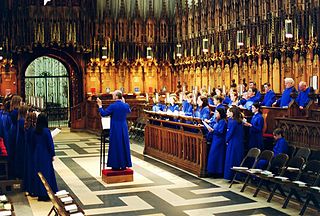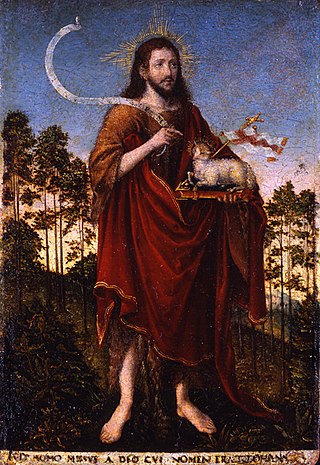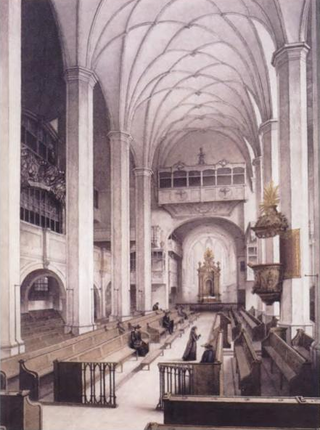Contemporary developments
The age of onset of puberty has declined to the early teens, so boys' choirs can no longer expect to retain a majority of their singers through the age of 16 or 17—as was the case when Bach wrote complex cantatas for the male treble. Boys' voices now break, on average, by the age of 13.5, [4] leading to higher choir turnover rates and limiting the complexity of a choir's musical repertoire. In addition to these challenges, there have been instances of sexual misconduct in some choirs and choir schools. [5]
Boys' choirs offer young males an active point of entrance into music and vocal training. They can also help to foster discipline, high standards and cultural awareness, as well as providing strong peer groups oriented around boys who identify themselves with a choir's cultural and ethical values. [6] A greater awareness of the value of gender-specific youth work may also support the positive contributions of boys choirs.
Many choirs also provide choir alumni with extensive opportunities—often coupled with continued vocal coaching—to support their vocal transition to altos, tenors and basses and to stimulate their continued artistic development.

A choir is a musical ensemble of singers. Choral music, in turn, is the music written specifically for such an ensemble to perform. Choirs may perform music from the classical music repertoire, which spans from the medieval era to the present, or popular music repertoire. Most choirs are led by a conductor, who leads the performances with arm, hand, and facial gestures.

A clef is a musical symbol used to indicate which notes are represented by the lines and spaces on a musical staff. Placing a clef on a staff assigns a particular pitch to one of the five lines or four spaces, which defines the pitches on the remaining lines and spaces.
A countertenor (also contra tenor) is a type of classical male singing voice whose vocal range is equivalent to that of the female contralto or mezzo-soprano voice types, generally extending from around G3 to D5 or E5, although a sopranist (a specific kind of countertenor) may match the soprano's range of around C4 to C6. Countertenors often have tenor or baritone chest voices, but sing in falsetto or head voice much more often than they do in their chest voice.
A male soprano or boy treble is a young male singer with a voice in the soprano range, a range that is often still called the treble voice range no matter how old.
SATB is an initialism that describes the scoring of compositions for choirs, and also choirs of instruments. The initials are for the voice types: S for soprano, A for alto, T for tenor and B for bass.

The Vienna Boys' Choir is a choir of boy sopranos and altos based in Vienna, Austria. It is one of the best known boys' choirs in the world. The boys are selected mainly from Austria, but also from many other countries.

Jesu, der du meine Seele, BWV 78 is a church cantata of Johann Sebastian Bach. He composed the chorale cantata in Leipzig for the 14th Sunday after Trinity and first performed it on 10 September 1724. It is based on the hymn by Johann Rist.

Freue dich, erlöste Schar, BWV 30.2, BWV 30, is a church cantata by Johann Sebastian Bach. It is one of his later realisations in the genre: he composed it for the Feast of John the Baptist in 1738, and based its music largely on Angenehmes Wiederau, a secular cantata which he had composed a year earlier. Christian Friedrich Henrici (Picander), the librettist of the secular model of the cantata, is likely also the author of the sacred cantata's version of the text.
Notable recordings of Johann Sebastian Bach's St Matthew Passion (Matthäus-Passion) are shown below in a sortable table.

Uns ist ein Kind geboren, BWV 142 / Anh. II 23, is a Christmas cantata by an unknown composer. In the Bach-Werke-Verzeichnis it is listed among the works with a doubtful attribution to Johann Sebastian Bach. The text is based on a libretto by Erdmann Neumeister first published in 1711. Although attributed to Bach by the Bach-Gesellschaft when they first published it in the late nineteenth century, that attribution was questioned within thirty years and is no longer accepted. Johann Kuhnau, Bach's predecessor as Thomaskantor in Leipzig, has been suggested as the probable composer, but without any certainty.
The listing shows recordings of the Mass in B minor, BWV 232, by Johann Sebastian Bach. The selection is taken from the 281 recordings listed on the Bach Cantatas Website as of 2018, beginning with the first recording by a symphony orchestra and choir to match, conducted by Albert Coates. Beginning in the late 1960s, historically informed performances paved the way for recordings with smaller groups, boys choirs and ensembles playing period instruments, and eventually to recordings using the one-voice-on-a-vocal-part scoring first argued for by Joshua Rifkin in 1982.
Recordings of the St John Passion are shown as a sortable table of selected notable recordings of Johann Sebastian Bach's St John Passion, BWV 245. The selection is taken from the 241 recordings listed on bach-cantatas as of 2015.
Kurt Equiluz was an Austrian classical tenor in opera and concert. He was a member of the Vienna State Opera as a tenor buffo from 1957 until 1983, remembered for roles such as Pedrillo in Mozart's Die Entführung aus dem Serail. He appeared regularly at the Salzburg Festival, including world premieres such as Rolf Liebermann's Penelope in 1954. He recorded works by Johann Sebastian Bach with conductors such as Michel Corboz, Helmuth Rilling and Charles de Wolff, and prominently as the Evangelist in the first recording of Bach's St John Passion on period instruments with the Concentus Musicus Wien in 1965, conducted by Nikolaus Harnoncourt.

Cantores Minores is a choir of the Helsinki Cathedral, and Finland's oldest and most successful boys' choir. The patron of the choir is the President of Finland. The choir consists of around three hundred 4- to 25-year-old boys and young men.

Johann Sebastian Bach composed the church cantata Ich elender Mensch, wer wird mich erlösen, BWV 48, in Leipzig for the 19th Sunday after Trinity and first performed it on 3 October 1723.

Johann Sebastian Bach composed the church cantata Ach! ich sehe, itzt, da ich zur Hochzeit gehe, BWV 162, in Weimar for the 20th Sunday after Trinity and first performed it in 1715 or 1716.

Christen, ätzet diesen Tag, BWV 63, is a church cantata by Johann Sebastian Bach. He composed the Christmas cantata for the First Day of Christmas, possibly in 1713 for the Liebfrauenkirche in Halle. He performed it again for his first Christmas as Thomaskantor in Leipzig, on 25 December 1723.

Meinen Jesum laß ich nicht, BWV 124, is a church cantata written by Johann Sebastian Bach. He composed the chorale cantata in Leipzig for the first Sunday after the Epiphany and first performed it on 7 January 1725. It is based on the hymn "Meinen Jesum laß ich nicht" by Christian Keymann.
Das neugeborne Kindelein, BWV 122, is a church cantata by Johann Sebastian Bach. Bach composed the chorale cantata in six movements in Leipzig for the Sunday after Christmas and first performed it on 31 December 1724.

J. S. Bach - Das Kantatenwerk is a classical music recording project initiated by the record label of Telefunken in 1971 to record all 193 sacred Bach cantatas. The project was entrusted to Nikolaus Harnoncourt and Gustav Leonhardt. Each conductor had his own instrumental ensemble, based in Austria and the Netherlands respectively.














